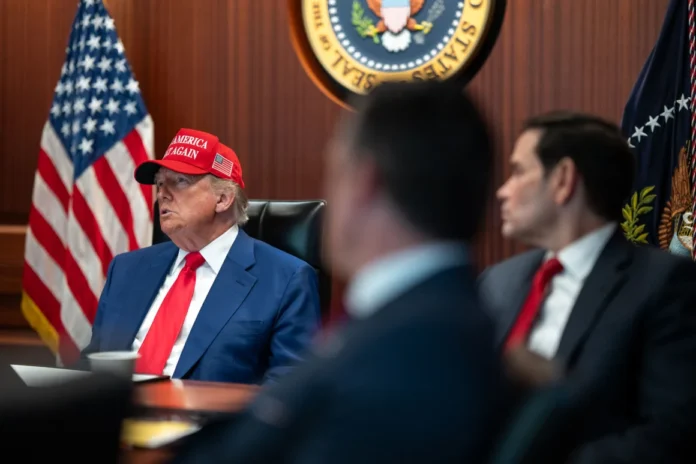On Friday night, while President Trump was strolling around his New Jersey golf club, the jets were about to take off.
Viewers inside the club could tell that Trump was unfazed by the prospect of severe consequences for US national security and his own presidency as a result of his order to attack three Iranian nuclear sites. From their base in Missouri, the B-2 stealth bombers were getting ready to take off at midnight, with 30,000 pounds of bunker busters on board. Their destination was Fordow, Natanz, and Isfahan.
In an effort to divert attention away from Trump’s insistence on total secrecy surrounding his historic decision, another group of planes was pointed westward.
According to those who saw him, Trump seemed carefree and amiable as he was brought by Sam Altman, CEO of OpenAI, to an event for new members held in one of the dining rooms of the clubhouse.
Trump remarked, “I hope he’s right about the AI,” while pointing to his visitor.
After twenty-four hours, Trump sat in the subterranean Situation Room of the White House, donning a red “Make America Great Again” cap, while he observed the attacks he had authorized a few days prior, dubbed “Operation Midnight Hammer,” unfolding on the wall of monitors in the facility.
“Tonight, I can report to the world that the strikes were a spectacular military success,” he remarked a few hours later during late-night remarks from the White House Cross Hall. Now is the time for Iran, the Middle Eastern bully, to make peace. The severity and ease of subsequent assaults will increase dramatically if they do not.
The decision to proceed with attacks brings the US squarely into the Middle East war, which in turn raises concerns about possible Iranian retaliation and queries about Trump’s ultimate goal. Trump had been publicly threatening to launch a military attack on Iran on social media and privately worried that doing so may plunge the United States into an extended conflict for days before he finally made up his mind.
One of Trump’s most momentous decisions as president was taken only 48 hours before the two-week public deadline.B-2 bombers flew out from Missouri at midnight ET on Friday for an 18-hour mission, the longest for the planes in over 20 years, according to Defense Secretary Pete Hegseth, who made the announcement during a Sunday morning Pentagon briefing.
“This is a plan that took months and weeks of positioning and preparation so that we could be ready when the president of the United States called,” Hegseth stated alongside Joint Chiefs of Staff Chairman Gen. Dan Caine. A high degree of accuracy was required. There was a great level of operational security involved, as well as deception.
First talks on possible US attacks
Over a weekend retreat at Camp David in early June, Trump and members of his national security team began to discuss options for American strikes on Iran in earnest. CIA Director John Ratcliffe briefed Trump on US assessments that Israel was prepared to begin strikes imminently.
In the months leading up to Trump’s decision, his aides had already ironed out their disputes over the various courses of action that might have him join Israel’s campaign.
Trump met daily with his national security staff in the basement Situation Room to review strike preparations and consider possible repercussions in the week leading up to his final order for US stealth bombers and Navy submarines to assault three Iranian nuclear sites.
The US assured Iran in back-channel talks that the attacks Trump authorized on Saturday would be limited and that no more actions were in the works moving ahead, according to two sources familiar with the matter.
The unpredictability of Trump’s time in the Middle East was further highlighted by his public statement Saturday night following the strikes, in which he threatened “far greater” US airstrikes in the future in response to Iranian retaliation.
Demanding action by April
In April, Trump gave Iran 60 days (by mid-June) to reach a nuclear agreement or face an ultimatum about the matter. Meanwhile, Trump appealed to Israeli Prime Minister Benjamin Netanyahu to refrain from invading Iran until the discussions have had a chance to demonstrate progress.
Midway through April, the United States and Iran convened their first round of negotiations in Oman. Steve Witkoff, Trump’s ambassador to the region, and Abbas Araghchi, Iran’s foreign minister, presided over the meeting. No real progress toward a nuclear agreement was made, despite the hopeful tones that rang after the talks.
U.S. officials were concerned that, following Friday’s meeting between European leaders and Iran’s foreign minister in Geneva, the Iranians would not meet with Trump unless he asked Netanyahu to end Israel’s strikes, a demand that Trump was reportedly unwilling to make.
During his commute to his New Jersey club that afternoon, Trump informed reporters that his two-week deadline was the “maximum” and that he may reach a decision sooner.
Nearly 125 planes were part in the US attacks.
The United States alerted Israel about its impending attack before Saturday’s attacks. The US strikes did not interrupt Netanyahu’s five-hour meeting with senior Israeli officials, as reported by an insider.
The prime minister of Israel, Benjamin Netanyahu, lauded the US strike in a video message, stating that it was executed “with complete operational coordination between the IDF and the United States military,” and Trump and Netanyahu spoke by phone again afterwards.
With no bullets fired at the US by Iran either on the way in or out, the US military “began its return home,” as Caine put it.
Trump informed the world about the strike on his social media network, Truth Social, after US jets had departed Iranian territory.
“A full payload of BOMBS was dropped on the primary site, Fordow,” Trump said, adding, “we have completed our very successful attack on the three Nuclear sites in Iran, including Fordow, Natanz, and Esfahan.”
